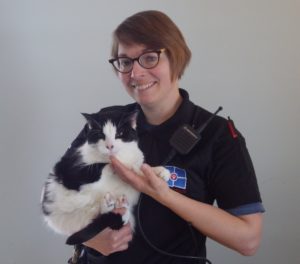There’s a reason Animal Control Officer Jackie Nowinski became known as the “cat liaison.” When she started working for Indianapolis Animal Care Services (IACS) in 2012, the city ordinance allowed Trap-Neuter-Return (TNR) for community cats. However, many of her fellow officers were skeptical of the approach, and the shelter didn’t have a program to support it.
Nowinski set out to bridge the gap between her fellow animal control officers, the community, and TNR. She tirelessly advocated for, and educated people about, TNRand six years later, it shows. In February 2017, the shelter implemented a community cat program, ensuring community cats brought to the shelter get spayed or neutered and returned to their outdoor homes.

Animal Control Officer Jackie Nowinski, pictured with her cat Simon, is a passionate advocate of Trap-Neuter-Return.
“We’ve come a long way,” she says, recalling that many animal control officers didn’t believe TNR would prove effective.
Nowinski, who had been an animal control officer for about five years before joining IACS, changed hearts and minds when she began working with local TNR group IndyFeral and its founder Lisa Tudor. Nowinski connected the organization with people who needed help with TNR or other matters involving community cats. Officers understood that if they had cat-related calls, Nowinski was the one to tap. She educated the public about community cats using Alley Cat Allies’ brochures.
Tudor, who now runs the IACS community cat program, says that Nowinski was an important ally for IndyFeral. Nowinski helped IndyFeral smooth over situations regarding community cats by talking to neighbors and providing authority that volunteers didn’t have.
“She kind of served as an educator and mediator,” says Tudor. “She’s a really good listener and just a problem solver.”
“She can come in with the authority in a compassionate way,” adds Judith Sawyer, a TNR advocate and volunteer. Sawyer recalled when a neighbor suggested poisoning community cats. Nowinski helped Sawyer’s neighbor understand that there are humane ways to keep the cats out of her yard.
“Jackie manages to really calmly and coolly diffuse these situations,” says Sawyer.
Over time, more animal control officers and the community embraced TNR. Nowinski “set the tone” for the other officers, showing them TNR was a legitimate approach, says Tudor.
“I think the community changed, too,” says Nowinski. “Citizens have said, “˜We want to help these cats.'”
Moreover, the shelter saw that TNR was working. The save rate at the shelter for cats and dogs has increased every year from 63.12 percent in 2013 to 86.34 percent in 2017. As of February 2018, the save rate for cats is 92 percent.
Shelters needs more animal control officers like Nowinski to protect and improve cats’ lives, says Tudor.
She continues to go above and beyond to help people with community cats, whether she guides them through the trapping process or traps the cats herself. TNR provides a way for animal control to truly support the community and its residents, she says.
“It’s great to help the cats, too, but when you help the people, they’re so appreciative that there’s a resource out there,” she says. “Then the word gets out that we’re not there just to round all the animals up.”
Advocating for TNR isn’t the only way Nowinski helps cats as an animal control officer. In December, she rescued a feral cat trapped at the bottom of a 6-foot-tall dumpster, by lowering a trap down with leashes. Other notable rescues include saving a kitten from a storm drain and a cat from inside a heating duct.
On her own time, she volunteers with Indy Cat Lovers, which raises money for TNR in the city and works to help keep pet cats in homes.
“I can’t say enough good things about what she’s done,” says Tudor. “There’s so many people who want to help outdoor cats, and I think you do need have officers who like and understand cats.”
Thanks Animal Control Officer Nowinski for the incredible work you do to help cats and your community!

